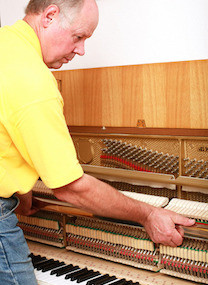How long has it been since you hired a technician to tune your piano?
Something happens to a piano when it is left untouched, untuned for a long period of time. With every year that passes, the pitch of your piano drops further and further from where it should be.
Overall, as a piano sits and absorbs the elements from the surrounding area, it will in general go flat in the colder winter months, than rise up in the summer, though in most cases the movement isn’t proportional. If this process continues time after time, it will be the job of the technician to bring it back into tune. And if and when you decide to tune it, it becomes more difficult for a piano tuner to pull it back up to its proper tension levels.
The piano contains over 200 strings, all that need to be adjusted during tuning. As a technician raises the tension of each string, it puts a lot of strain on the piano’s structure. It’s impossible to make a large jump and have a stable tuning in one pass. So the technician must spend the time raising each of the strings up to their average tension levels, then move forward once again to accurately bring it into tune. This is called a pitch raise.
The process continues until the piano is deemed to be in tune.
Also keep in mind that when a piano goes through this much adjustment at one setting, the likelihood of it moving back out of tune increases as well. It is recommended to have the piano tuned again within a six month period of time to help keep the tension level of the strings more stable.
Once a piano is back in tune, a regular tuning schedule (every six months to one year) will prevent the need for a pitch raise in the future. Like many things, regular maintenance will keep your piano in the best possible performance level.


